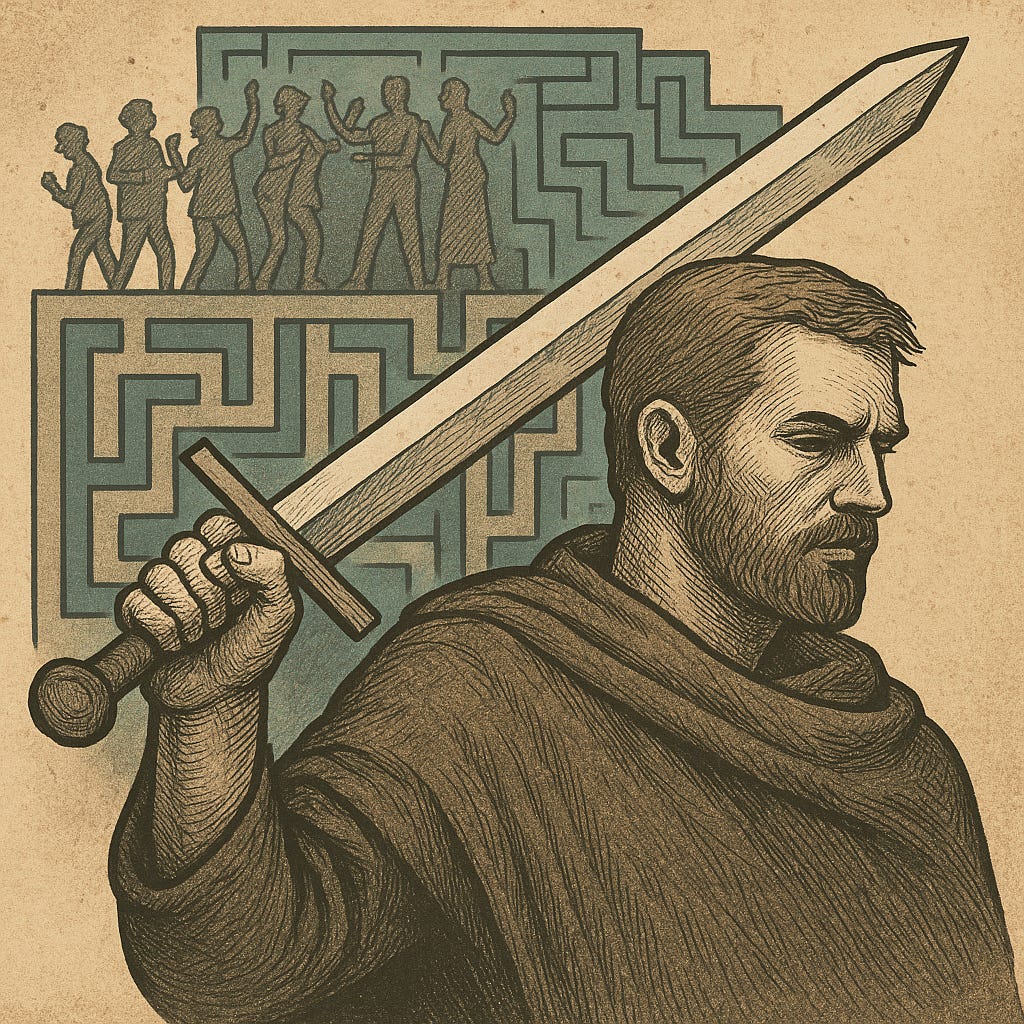There is a kind of paradoxical courage in restraint, particularly in the art of observation without indictment. Within the architecture of modern cultural discourse, there exists a structural tension between those who seek to design the scaffolding of social change and those whose lives are meant to inhabit that structure. We might call the former the conceptual vanguard—the system-builders, the theorists, the public-facing midwives of utopian possibility. The latter, often mislabeled as the masses or the proletariat, are less abstract, more kinetic, and infinitely more difficult to shape.
This dichotomy has been rehearsed endlessly, from the salons of Paris to the committee rooms of the DSA, from the corridors of elite Ivy League institutions to the hollowed-out storefronts of transitional urban neighborhoods. Every idealistic project, no matter how rigorously conceived, eventually encounters the friction of handoff. The vision is incubated in small rooms filled with whiteboards and well-intentioned jargon; it is then delivered, in various states of readiness, to a reality that neither asked for it nor respects its terms.
In every revolution, in every campaign of reform or restoration, there is the handoff moment: the passing of the torch from theory to practice, from the architectural sketch to the contractor on-site. And invariably, something gets lost. Or burned. Or casually discarded. This is not a moral failure; it is a function of thermodynamics. Heat escapes. Precision blurs. And the very people for whom the structure was allegedly built begin to use it in ways the architects never anticipated.
One could make a soft analogy to the marshmallow test—that old psychological parable about delayed gratification. The conceptual vanguard, having spent years in ascetic devotion to deferred outcomes, constructs elaborate systems requiring patience, discipline, and incrementalism. But the recipients, often hungry from a lifetime of systemic neglect, consume the marshmallow before the experiment even begins. Sometimes they find the whole bag. Sometimes they eat the experimenter. This is not a deficiency; it is a different logic of survival.
Nowhere is this dynamic more vivid than in the well-meaning attempts to "fill food deserts" or deliver corporate mercy into neglected neighborhoods. The cycle is nearly mythological in its repetition: elite policy graduates draft white papers on access and equity, socially conscious corporations agree to plant a flagship location in an underserved area, and within a decade, the experiment ends in retreat. The reasons are always framed delicately—"unsustainable margins," "security concerns," "community misalignment"—but the quiet truth is this: the organism rejected the transplant.
What survives in these places are not Whole Foods and REIs but Korean groceries, fortified bodegas, and Chinese takeout counters with thick Lexan windows. These are not monuments to utopia. They are adaptable, defensive architectures—resilient not because of any systemic alignment, but because they evolved to survive distrust, theft, economic pressure, and moral ambiguity. They are, in effect, commercial gray men: invisible, unflashy, resilient.
The gray man archetype, incidentally, is one the author knows well. Having survived Hawaii not by dominance but by calculated invisibility, by de-escalating threats and grinning like an idiot while mapping exits, by weaponizing the performance of cowardice, he has lived his life in the uncanny valley between self-preservation and sublimated menace. Performative cowardice, after all, is often the camouflage of latent capability. And while most cowards flee, some—armed, patient, underestimated—wait for the moment the odds invert. Engage such a coward at your own peril, for you may discover you were not dealing with a bunny, but a bear in a windbreaker.
The right, for all its narrative flaws, has long trained this gray-man class in silence and strategy. Back when the left was still focused on symbolic protest, the right was graduating generations of operatives from leadership institutes that specialized not in street theater but in appellate law, regulatory chess, and the long game of cultural terraforming. Roe v. Wade was not undone in the streets but in the filing cabinets of forgotten NGOs and legal foundations whose interns are now judges. The gray men won. And no one noticed.
In contrast, the left's vanguard often insists on spectacle. And spectacle, like shouting at a crocodile, draws heat. Every generation produces its stage moms of ideology, its showrunners of justice, its directors who can't resist inserting themselves into the credits. But in the end, as in Wag the Dog, it is often the one who seeks credit who gets eliminated. The lesson is ancient: stay small, do your work, disappear.
Perhaps the better metaphor is not the marshmallow test, nor the rubber room, nor even the tragic arc of the director in Wag the Dog. Perhaps the best metaphor is the airlock. The vanguard believes they are entering the ship, participating in the mission, contributing to the great experiment. But they are still in the transition chamber, being monitored, pressure-tested, filtered. Few ever enter the ship proper. Many are left suspended, indefinitely, in a sealed waiting room of narratives about progress.
And it may be that the wisest course is not to bang on the airlock door, demanding access or recognition, but to study its structure, learn its rhythms, and find ways to breathe within it. Because for all the high theory and performative justice of our age, the quiet truth remains: survival belongs to those who are underestimated long enough to finish their work.
Which is to say: the broadsword you never see swung is the one that cleaves the world in two. And the director who demands applause rarely gets to see the credits roll.
tl;dr
The provided text, "Wag the Vanguard," explores the dichotomy between conceptual "vanguards" and the realities of implementing social change. It argues that well-intentioned theoretical frameworks often fail when introduced to practical, lived experiences—much like a planned structure being rejected by those meant to inhabit it. The author suggests that true resilience and effectiveness are found not in grand spectacles or seeking credit, but in adaptability, quiet work, and a "gray man" approach that operates subtly and often unobserved. This is contrasted with the left's tendency towards public display, while the right's unseen, strategic efforts have historically yielded significant results. Ultimately, the text advocates for underestimated, patient work over performative actions as the true path to lasting impact.
Appendix A: Cowardice as Strategy — Attributed Quotations
"Appear weak when you are strong, and strong when you are weak."
— Sun Tzu, The Art of War
"The supreme art of war is to subdue the enemy without fighting."
— Sun Tzu
"He who knows when he can fight and when he cannot, will be victorious."
— Sun Tzu
"To know your enemy, you must become your enemy."
— Sun Tzu
"Let your plans be dark and impenetrable as night, and when you move, fall like a thunderbolt."
— Sun Tzu
"There is no greater danger than underestimating your opponent."
— Laozi, Tao Te Ching
"He will win who knows how to wait to fight, not rush to fight."
— Sun Tzu
"Retreat is not surrender—it is the preparation of ground on your terms."
— Miyamoto Musashi, The Book of Five Rings
"The essence of strategy is choosing what not to do."
— Michael Porter (Business strategist, but deeply Sun Tzu–influenced)
"In war, numbers alone confer no advantage. Do not advance relying on sheer military power."
— Sun Tzu
"All warfare is based on deception."
— Sun Tzu
"Victorious warriors win first and then go to war, while defeated warriors go to war first and then seek to win."
— Sun Tzu
"Conceal your intentions until the moment of execution."
— Niccolò Machiavelli
"Bravery in battle is easy. Bravery in retreat is rare."
— T.E. Lawrence (Lawrence of Arabia)
"The greatest victories are won by those no one notices until it's too late."
— Anonymous OSS Manual, WWII (Office of Strategic Services)
"There is no shame in a quiet war. Only in a noisy defeat."
— Clausewitz, paraphrased from On War
"It is the mark of a true general to profit by his enemies' mistakes and not be drawn into rage by provocation."
— Sun Tzu
"Run from the tiger you cannot beat. Circle back as the wind and poison its water."
— Unknown, from Zhan Shu Ji (战术集), a lesser-known Chinese tactical text
Appendix A.1: “Live to Fight Another Day” — Cowardice, Feigned Death, and Strategic Retreat
“He who fights and runs away may live to fight another day.”
— Demosthenes, ancient Athenian orator (though often misattributed to Tacitus or Menander)
“Feign disorder, and crush him.”
— Sun Tzu, The Art of War
“Feign death to draw out the predator.”
— Zulu Proverb
“Yield and overcome.”
— Laozi, Tao Te Ching (Chapter 22, on the strength of flexibility)
“Sometimes survival is the boldest act of all.”
— Atahualpa, last Inca emperor (attributed posthumously)
“Bend like the reed, not break like the oak.”
— Chinese Proverb, also echoed in Aesop's The Oak and the Reed
“Lie low to rise high.”
— African Proverb, Ghanaian origin
“Pretend to be a sheep if you want to live among wolves.”
— Russian Proverb
“Playing dead is the first tactic of the hunted.”
— Native American Saying (source unclear; referenced in oral histories from Plains tribes)
“To run away is not to abandon honor, but to choose the ground where honor can be won.”
— General Vo Nguyen Giap, North Vietnamese commander
“One must sometimes disappear to remain dangerous.”
— French Resistance Manual, WWII
“The turtle survives not by speed but by shelter.”
— Zen Saying, possibly a haiku-derived proverb
“The storm passes. The crouched man rises.”
— Japanese Proverb (related to nana korobi ya oki — fall seven times, rise eight)
“Better a live dog than a dead lion.”
— Ecclesiastes 9:4, Hebrew Bible
“A snake that cannot strike must learn to slither unseen.”
— Indian Proverb, possibly from Arthashastra
“Die on your feet, or live on your knees—but don’t let them know which it is.”
— Apocryphal, used in various revolutionary contexts
“Sometimes the best way to win is to make them think you’re already defeated.”
— U.S. Army Special Forces Manual, paraphrased
Appendix A.2: Concealed Intent and Tactical Obscurity
“Conceal your intentions until the moment of execution.”
— Niccolò Machiavelli, The Prince
“When you are strong, appear weak.”
— Sun Tzu, The Art of War
“To surprise is to disarm.”
— Napoleon Bonaparte
“A drawn weapon warns; a hidden one decides.”
— CCW Instructors’ Axiom (modern concealed carry doctrine)
“The most dangerous man in the room is the one no one noticed.”
— Law Enforcement Aphorism, unattributed
“Silence is the armor of the armed.”
— Israeli Defense Forces Saying
“The blade you never see is the one that cuts deepest.”
— Persian Proverb
“Patience is not inaction—it is preparation.”
— Taoist Maxim
“The moment of advantage belongs to the one who watched longest.”
— Japanese Koryu Tradition
“The man who smiles, waits.”
— Southern U.S. Saying, also used in Appalachian CCW circles
Appendix A.3: Addenda to the Doctrine of Calculated Retreat
“He who fights and runs away lives to fight another day.”
— Demosthenes, attributed; later popularized by Tacitus and Menander
“Feign disorder, and crush him.”
— Sun Tzu, The Art of War
“In war, the greatest asset is to be underestimated.”
— Carl von Clausewitz, paraphrased
“Discretion is the better part of valor.”
— Shakespeare, Henry IV, Part 1
“Cowardice? No. I call it staying alive.”
— R.A. Salvatore, The Crystal Shard (via the rogue character Regis)
“Retreat is not surrender. It is the preparation of terrain.”
— Mao Zedong, military notes, 1936
“Let others shout. You should wait.”
— Chinese proverb, often cited in martial strategy
“You can only ambush from the shadows.”
— Modern SOF (Special Operations Forces) maxim
“If you know when to leave, you never have to run.”
— Nomad proverb, source unknown
“The mouse that escapes teaches its children where not to tread.”
— Berber saying
“A closed mouth gathers no flies… or bullets.”
— Appalachian firearm culture, folk wisdom
“A lion doesn't roar when it stalks.”
— Zulu proverb













Share this post